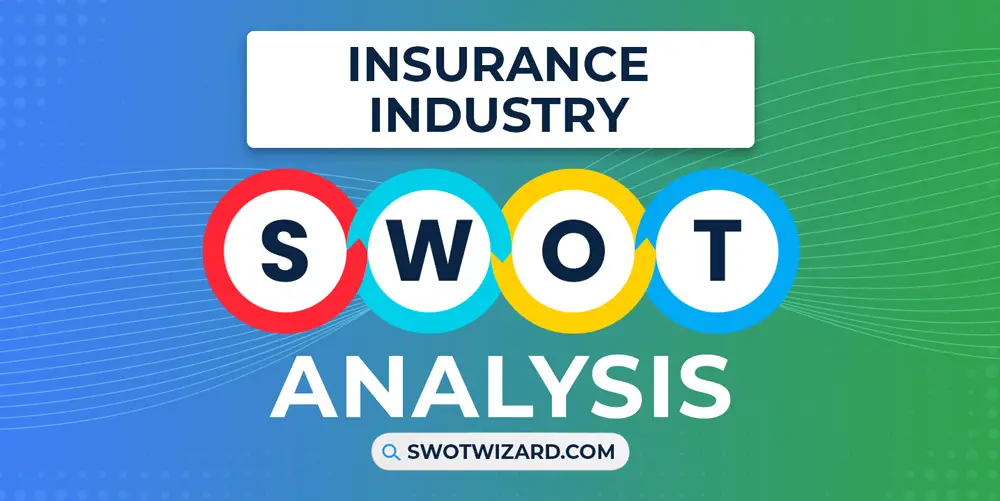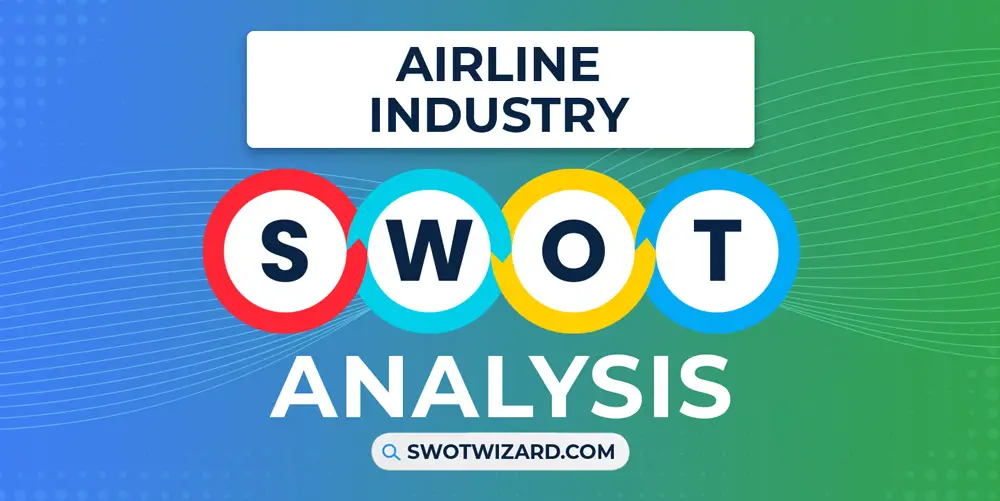In the old days, people used to keep insurance for their lands, houses, and valued items. In modern days, the system trends and everything related to the insurance industry has changed significantly.
People can now do life insurance, pay for a particular time, and enjoy the fruit afterward. The industry’s perspective was like this a couple of decades ago, but with modernization, the generation now has a different perspective. And with that, the industry has new strengths, weaknesses, opportunities, and threats, which we will learn in the insurance industry swot analysis.
Insurance Industry Overview
The first-ever insurance contract was signed in 1347 in Italy. After that, centuries passed, and now we have the modern insurance industry worth over $5946 B in 2022, with the largest markets being the US, China, and Japan.
The insurance industry has experienced steady growth, with a compound annual growth rate of 7% from 2012 to 2022 globally. The total number of employees in the insurance industry stands at 2.8 M in the USA alone and millions more worldwide.
Competitors in Insurance Industry
Ping An Insurance Group | UnitedHealth Group | Allianz | AXA Group | AIA Group | MetLife | Zurich Insurance | Cigna | AIG
Did You Know?
A famous bassist named Gene Simmons from a KISS band insured his tongue for $1 M in 1970’.
Strengths – Insurance Industry SWOT Analysis
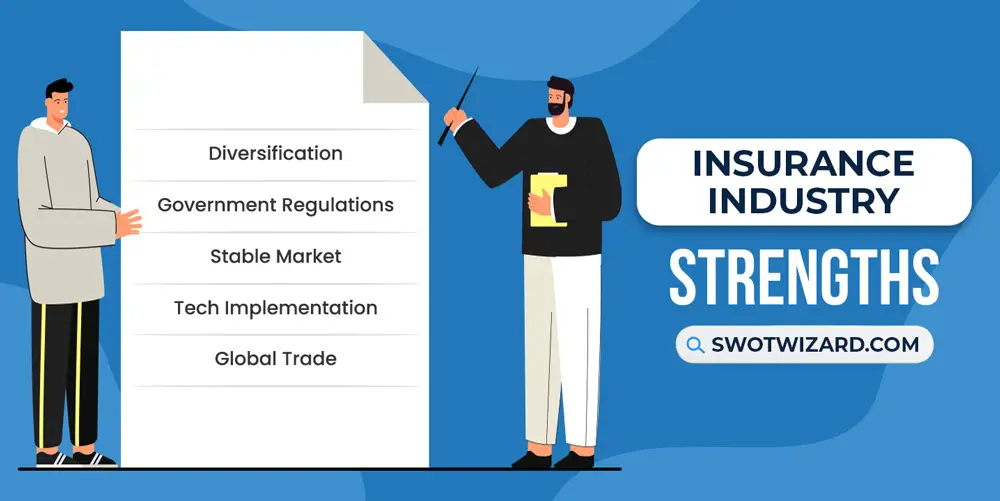
Diversification: The insurance industry caters to every type of product, service, and business in the market. Whether it’s a property, your new car, or anything that you feel needs insurance, there are insurance companies that will meet your need. That way, anyone can keep their valuable and new assets secured.
Government Regulations: The governments are very protective of the insurance sector in their countries, not just by making laws and regulations but also by the strict rules to prevent fraud. Some countries have particular insurance policies for their growing sectors, such as Agriculture, RMG, and specific insurance to help them. As a result, this helps to maintain a healthy environment and steady cash flow.
Stable Market: A few industries, including the insurance industry, stayed steady during the economic downfall. Stability made it possible for companies to remain in business even during hard times because people need security and protection during these times more than ever. And, despite all factors, the stats show a stable insurance market with an average 6.5% global growth rate in 2023.
Tech Implementation: In the past couple of decades, tech has advanced in many ways and impacted every sector, so in the insurance industry, such as consumer data, age groups, trends, risky products in the future, etc. That way, insurance companies can now design and develop their products and services to cater to customers in better ways.
Global Trade: Globalization has been a blessing for us, and people can enjoy products and services from the other side of the world. And one of the biggest customers of the insurance industry is the global trade products, services, and the total amount sums up to around $90 B in the last quarter of 2022 in the USA alone.
Weaknesses – Insurance Industry SWOT Analysis
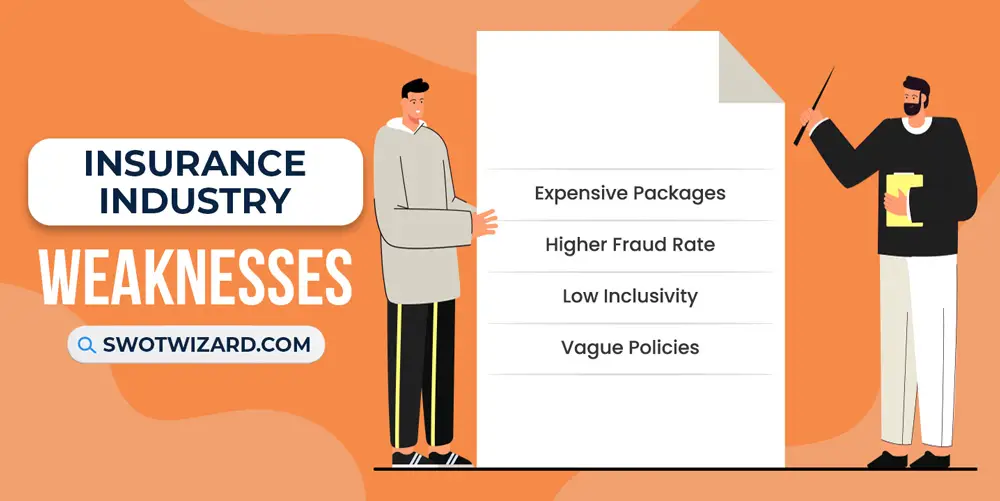
Expensive Packages: Whether it’s five-year insurance or even less, the insurance plans can be very expensive. For example, on average, car insurance can be a minimum of $2K per year and depending on the car model, the amount could be years in the USA. Another example, could be life insurance, which can cost on average $250K per year and even more in some cases. Besides, all products in the industry can be costly.
Higher Fraud Rate: The insurance industry has one of the most fraud cases compared to other sectors, with an average 10% global rate. Besides, in 2022 alone, the total fraud cases were more than $300 B in the USA alone. Even some local companies had to shut down their operation because of bankruptcy.
Low Inclusivity: The general insurance packages have little to no inclusivity. Even the smallest basic human things, such as, aren’t considered. But, in those cases, when age vulnerability, sickness, other crises, and other items are considered, the package rates get higher, which these people can’t afford. As a result, it seems cruel in most cases, and the industry has a bad reputation for it.
Vague Policies: In an industry this big, there are fraud cases from the customer’s and company’s end. Many companies scam customers with these tricks, tactics, and other vague policies. It is almost impossible to prevent fraudulent activities, but there are authorities, such as in India, to reduce and protect customers’ claims.
Opportunities – Insurance Industry SWOT Analysis

Growing Economy: The global economy is booming, and people’s buying power has increased immensely. As a result, they have more assets, and they want insurance for them. Targeting specific markets with their need can bring more customers, steady the cash flow, boost economic growth, and increase the insurance market size.
Diversify Offerings: Most packages don’t offer a lot of options. Besides, low inclusivity has always been an issue. Offering diversified options could be short-term, small-amount packages, which can be affordable to even lower middle classes, which will change the game. That way, the customer base, and many other options will increase, and we can already see the changes in India’s “Insurance for All” initiatives.
Digital Assets: The digital asset market is growing immensely, and it will be one of the largest markets in 2023, with $46,240 in revenue. And the amount will double in the next four years. And every digital asset owner will need insurance on these valuable assets, which insurance companies can capture with proper marketing channels and a few more efforts. As it will become one of the largest markets, the industry should focus on this sector.
Green Energy Packages: The whole world is moving toward green energy, and it is a perfect opportunity for insurance companies to develop and offer those related packages. We can see that wave and many recent green-energy insurance offerings in Australia are already associated with this sector.
Collaborative P&R: An effective policy and regulatory system to prevent fraudulent activities and help companies and customers keep the transactions in check, and such might work toward an efficient work process. One of the ways to do that is to modernize the entire insurance system, including management and operations, and implement innovative tech in the system.
Threats – Insurance Industry SWOT Analysis
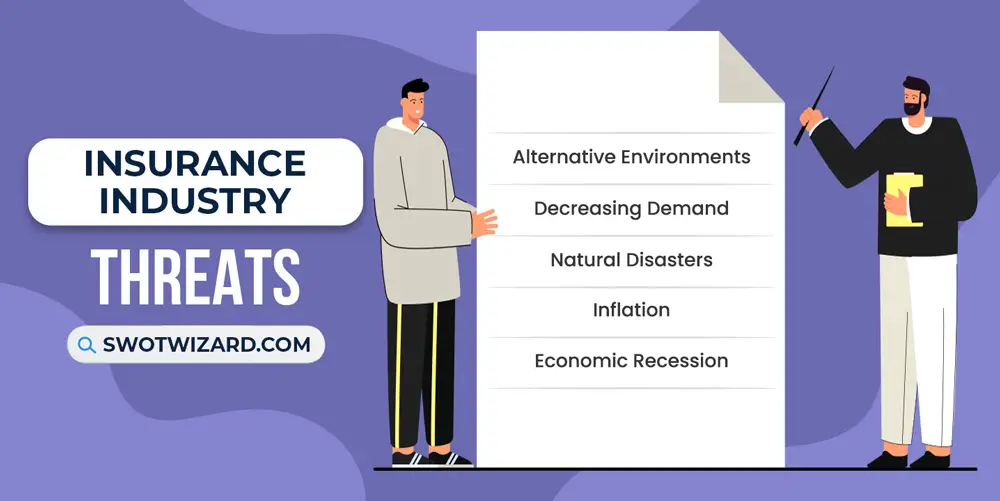
Alternative Environments: A few decades ago, the insurance business was something everyone wanted, but the environment has changed a lot ever since. Besides, with the outdated policies and regulation system, the new generation doesn’t trust insurance much with all these alternative investment options and economic changes.
Decreasing Demand: There are many reasons for the declining trend in insurance, especially after covid-19, such as insurance companies being unable to pay the maturity profit and not paying timely, poor regulation, trust, etc. As a result, the entire industry is growing through a vast declining trend, and they don’t know how to get it back on track.
Natural Disasters: Noone has the hands of natural disasters, but it sure is one of the most significant threats to insurance companies, meaning entire industries. There are many incidents where the companies paid later, after a long legal battle and didn’t pay at all, which ultimately led to losing trust in the industry and losing clients.
Inflation: Although inflation could be a good thing, in some cases, it could be a threat. Depending on the country, company insurance policies, insurance rate, event, and inflation rate, companies might have to pay double or triple after or when that inflation is happening at a greater rate, which could be in 2023.
Economic Recession: A global recession means that people and businesses spend more on necessary basic things and less on costly items like insurance packages. As there are clear signs of a recession in 2023 and the economy is slowing down, the insurance industry is facing a challenge as the interest in insurance items is getting lesser.
[Bonus Infographic] SWOT Analysis of Insurance Industry
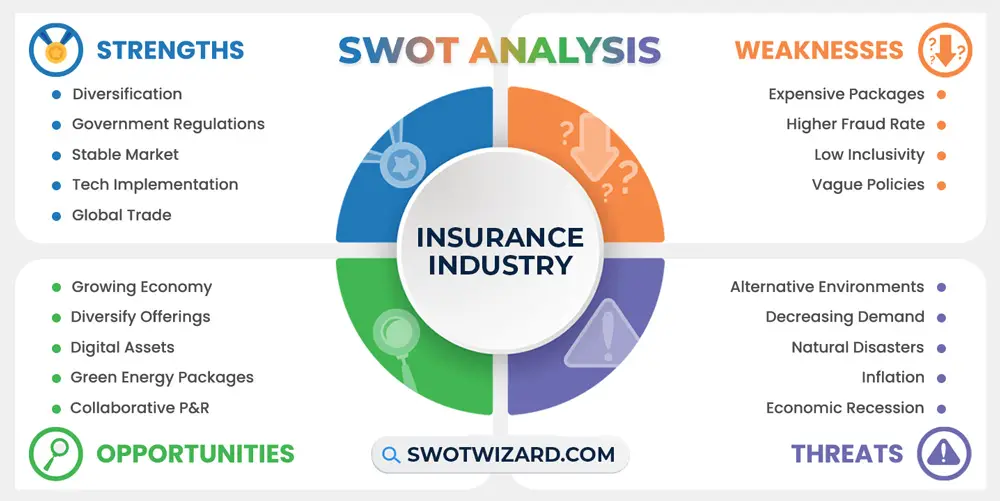
Recommendations for Insurance Industry
With modernization, as there are many new opportunities, and there are also threats to the insurance industry. Here are how the companies can grab those opportunities and tackle those threats;
- The priority should be on the green energy-related insurance packages, as the other industries are going onward that way.
- The tech and virtual-based industries are booming, and that sector is easier to grab.
- The industry could modernize life insurance packages with better offerings.
- More innovative and dynamic offerings could attract more customers.
- Developing effective and efficient value realization policies could bring change.
- Tackling fraudulent activities with better tech can save money, time, and energy.
Frequently Asked Questions (FAQs)
What are the 4 Most Common Types of Insurance?
The four most common types of insurance are health, auto, long-term disability, and life.
What are the Big 3 Insurance Companies?
The big three insurance companies are Allianz, Axa, and Prudential Financial.
Final Words on Insurance Industry SWOT Analysis
The insurance industry changed significantly with upcoming trends and diversified offerings and played an essential role by providing financial security to the people. As technology evolves, the insurance industry must adapt to remain competitive and offer innovative solutions, such as green energy packages, diversified offerings, and digital assets. And to tackle threats and weaknesses, it must embrace new technologies, manage emerging risks, and maintain customer trust.
References
- Understanding Your Insurance Policy. (n.d.). Department of Insurance, SC – Official Website.
- Clarke, D., & Lung, F. (2015, September 18). Should governments support the development of agricultural insurance markets? World Bank Blogs.
- Global Insurance Report 2023: Expanding commercial P&C’s market relevance. (2023, February 16). McKinsey & Company.
- Kumar, P. (n.d.). Impacts of information technology in insurance industry. Legal Service India.
- Trade Credit Insurance Market Size & Trends Report, 2030. (n.d.). Grand VIew Research.
- Gusner, P. (2023, January 3). Average Life Insurance Rates Of February 2023. Forbes Advisor.
- Fraud Stats. (n.d.). InsuranceFraud.org.
- Sinha, S. (2023, February 23). Life insurance is going to be costly now – Here’s why. Financial Express.
- Shahi, C. (n.d.). Vague and Unclear Terms and Conditions of an Insurance Policy-: An Instrument For Insurance Company. Legal Service India.
- Mullaney, T. (2022, August 23). After a year-long dip, American consumer spending power will be back in 2023. CNBC.
- Enabling Insurance for All. (2023, February 23). CII Blog.
- Digital Assets – an emerging trend in capital markets. (2022, July). PWC.
- Renewable energy insurance services provider launches in Australia. (2023, February). Business Insurance.
- Meredith-Miller, B. (2022, February 8). Younger consumers struggle to trust their insurance agents. PropertyCasualty360.
- Habib, A. (2022, August 23). Profit declines for insurers. The Daily Star.
- Fry, E. (2021, August 9). ‘Almost everyone is getting screwed’: After climate disasters, homeowners find their battle with insurers is just beginning. Fortune.
- Oğuz, S. (2023, February 8). Mapped: 2023 Inflation Forecasts by Country. Visual Capitalist.
- IZUCHUKWU, C. (2022, November 2). In the slow lane: a recession’s implications for insurance. The Actuary.

